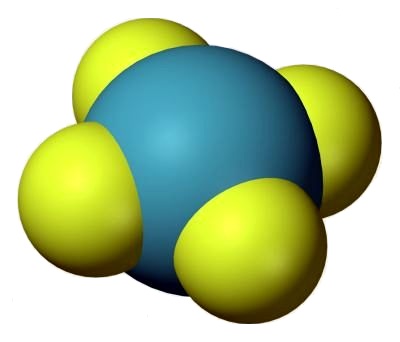
There are millions of compounds. Some of them are even inert gas compounds.
We were taught in high school that there are special, inert gases in the Periodic Table. These include radon and krypton, and are found in the column furthest to the right of the table. But that was then. Now we will learn that not all of those gases are all that inert.
In addition to being called inert, the far right column gases are sometimes called rare or noble gases. These gases have a completed outer shell of electrons. So it would seem they should have no tendency to gain or lose electrons. But just how true is that? Can inert gases form compounds?
Platinum Hexafluoride
Platinum hexafluoride is formed by reacting a platinum metal atom and three diatomic fluorine molecules. The hexafluoride is a red, volatile solid that can abstract an electron from a molecule of oxygen. That is no easy task. The reaction is,
PtF6 + O2 → (O2)+(PtF6)–
This accidental discovery in 1962 by Neil Bartlett occurred when oxygen leaked into a reaction apparatus containing vaporized platinum hexafluoride. From its crystal structure, he determined that the diatomic oxygen in the orange solid had undergone the removal of an electron, which takes 1175 kJ energy per mole!
By comparison, xenon takes 1170 kJ per mole. It should be possible to form the hexafluoroplatinate of xenon. In fact, Nobel Prize winner Linus Pauling had predicted in 1932 that it should be possible to form xenon hexafluoride, plus other oxygen containing compounds. In fact XePtF6, xenon hexafluoroplatinate, was the first prepared xenon compound.
Inert Gas Compounds: Xenon Oxy-Compounds
Using fluorides of xenon as the starting material, oxygen containing xenon compounds can be prepared. Reaction occurs with water or silicon dioxide molecules. For instance,
2 XeF6 + 3 SiO2 → 2 XeO3 + 3 SiF4
The trioxide is an explosive, subject to heat and shock.
In addition to oxides, xenon forms hydrates called clathrates.
But How Can Inert Gas Compounds Form?
Xenon can form compounds because of the size of its atom. Helium, neon, and argon gases are much smaller and have no tendency to form compounds. Krypton does form a difluoride given special conditions. The large size of xenon places its outermost electrons at a great distance from the nucleus. This makes them prey for the extremely electronegative fluorine.
Radioactive radon should be even more reactive than xenon. In fact, it can form compounds, but due to its short half-life, they are unimportant.
Note: You might also enjoy What are Allotropes?
References:
- Elements of the p block by Harding, et. al.
- Oregon State University: The Xenon Conundrum
- High-pressure transformations in xenon hydrates
← Back to Quirky Science Nuggets
← Home

I seem to recall the word “clathrate” being used for a naturally occurring compounds either under water at deep pressure or in frozen conditions?